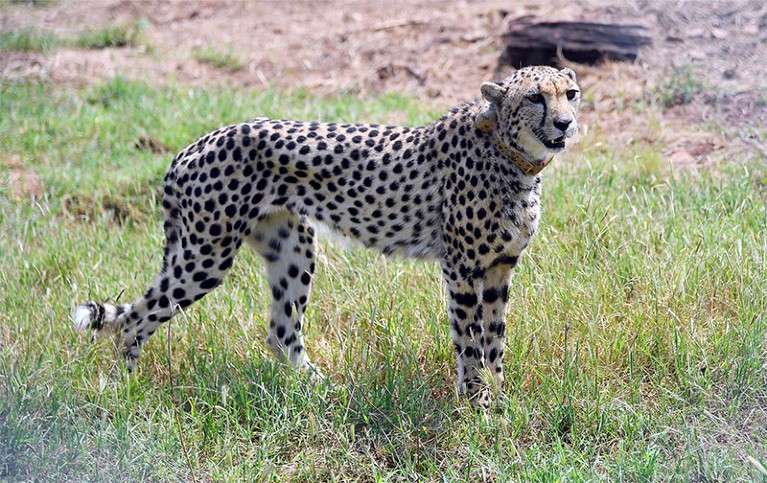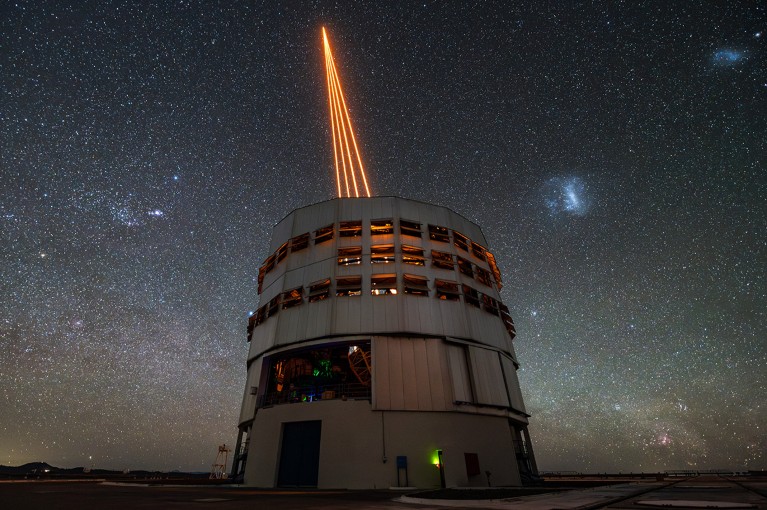Hello Nature readers, would you like to get this Briefing in your inbox free every day? Sign up here.

The first African cheetah introduced to India last September gazes at its new home.Credit: Press Information Bureau/PIB Photo/Alamy
Indian national park too small for cheetahs?
The future of the world’s first intercontinental cheetah-introduction programme is under question after it emerged that three relocated animals, and three of their cubs, had died in the space of eight months. Last September, India launched with great fanfare the ambitious programme to introduce the South African cheetah (Acinonyx jubatus jubatus) into Kuno National Park. Critics say the park is too small for the intended number of animals, and that local farmers have not been properly prepared. “The fact that we had multiple [adult] deaths occurring in a short space of time is not unusual in the sense that it’s the high-risk period,” says veterinarian Adrian Tordiffe, a consultant for the project. However, “I wasn’t expecting these cubs to succumb,” he says.
Mother pardoned thanks to new science
An innovative science advisory panel has been instrumental in securing the release of Kathleen Folbigg, who spent 20 years in jail in Australia for killing her four infant children. New genetic evidence came to light in 2018, indicating that there was a reasonable possibility that the children had rare genetic mutations that could have caused their sudden deaths. A new inquiry was opened, with the Australian Academy of Science acting as a scientific adviser. It recommended scientific expert witnesses, and they spent time explaining the cutting-edge science to both the defence and prosecution. “Science was heard in this case,” says protein scientist Michael Toft Overgaard, who was an expert witness at the inquiry.
Read more: She was convicted of killing her four children. Could a gene mutation set her free? (Nature | 17 min read, from 2022)
China could see frequent COVID waves
The COVID-19 wave currently rolling through China could infect more than 400 million people — almost one-third of the population. China will probably see similar infection cycles every six months now that all restrictions have been removed. The latest surge, caused by the highly infectious Omicron subvariant XBB.1.5, is unlikely to crash the country’s health-care system. “The fear is that this virus will produce a new variant that can compete with the current ones and is more severe”, says epidemiologist Ali Mokdad. Current jabs provide protection against severe disease and death, and China is developing vaccines targeting XBB specifically.
Shingles jab might cut dementia risk
Vaccination against shingles might lower the risk of dementia, such as that caused by Alzheimer’s disease, by 20%, according to an analysis of health records from nearly 300,000 people in Wales. “If it is true, it’s huge,” says epidemiologist Alberto Ascherio. The idea that there’s a connection between dementia and some viruses — such as the varicella zoster virus, which causes shingles — is controversial. Some scientists urge caution because the study didn’t examine whether the vaccine just delays the onset of dementia, which can develop over decades, and the effect seemed to apply mainly to women.
Reference: medRxiv preprint (not peer reviewed)
Tanzania offers cash for publication
Tanzania’s government is offering 50 million Tanzanian shillings (roughly US$22,000) to scientists who publish their work in a high-impact international journal. Some have welcomed this as a much-needed incentive to conduct research in a country where most academics are focused on teaching. Critics argue that the plan rewards established researchers rather than encouraging those at earlier career stages. “There won’t be high-quality papers in high-impact journals if scientists are not free to choose what they study and be free to do so based on scientific principles, not politicians’ whims,” says Aneth David, a microbiologist in Tanzania.
Features & opinion
Polio doctors pioneered intensive care
A polio outbreak in 1950s Denmark led one hospital to pioneer mechanical ventilation, constant monitoring of vital signs and other innovations that have become staples of today’s intensive care units. In her book The Autumn Ghost, Hannah Wunsch provides a detailed history of polio and its vaccines, the first ventilator machines (known as iron lungs) and the rise of anaesthesiology — a story that has rich parallels to the COVID-19 pandemic, writes reviewer and cardiologist Eric Topol. “But she really hits her stride when she describes those whose lives were saved,” he says.
Visit three scientific utopias
Many researchers dream of a better scholarly world. Earlier this year, Nature co-sponsored a science-fiction competition run by EU-LIFE, an alliance of European research institutes, asking for visions of a scientific utopia.
• The winning story by Katherine Ember fast-forwards to 2053. In Tackling an early-morning crisis at the Institute of Merged Sciences, researchers have an immediate responsibility to the public.
• In runner-up Evandro Ferrada’s The Eclosion Event, science and a research culture are transformed by limitless energy.
• Runner-up Miles Lizak’s Scientific enlightenment in the Stupid Questions Office highlights the benefits of asking brave questions rather than claiming to know all the answers.
Image of the day

Credit: ESO
This striking image shows four powerful lasers that form part of the Very Large Telescope in the Atacama Desert, Chile. The lasers make sodium atoms in the atmosphere glow like artificial stars, allowing the telescope to correct for atmospheric distortion of the light from real stars, and to create sharp images. The Very Large Telescope — run by the European Southern Observatory — obtained its first images 25 years ago, and has since been involved in key research including studies of the supermassive black hole at the centre of the Milky Way. (Nature | 2 min read)
